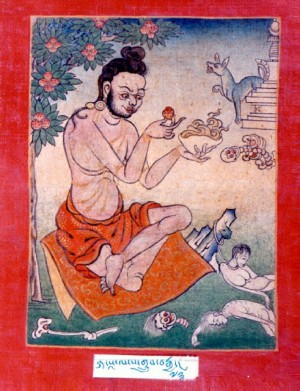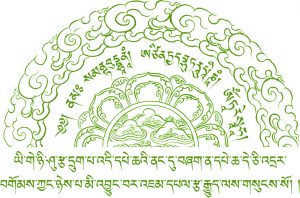An epidemic fever swept the city of Rajapuri. The beloved wife and his 5 sons died of the fever. Grief-stricken, he sat at the cremation ground beside what had once been his loving family. The guru Krsnacarya appeared and sat down with him to offer comfort. The poor man said that nothing is left for him as all his happiness is taken away from him and so he wishes to remain there next to his family until he die too.
The yogin replied, “All beings of the three realms live under a cloud of death. This suffering has not come to you alone. But since you feel you can no longer be of use to yourself or others, why not practice a sadhanas?” Kapalapa begged for his teachings and the yogin initiated him into the mandala of Hevajra, then instructed him in the creative and fulfillment stages of meditation.
The yogin carved the ornaments of the 5 Dhyani Buddhas (crown, earrings, necklace, bracelets, and belt, and the trident of the dakini) from the bones of his sons, attaching a sacred thread. Lastly, he fashioned a skull bowl from his wife’s corpse. Handing all these to Kapalapa, the yogin said, “Visualize this skull as the form of creative meditation. See emptiness it contains as fulfillment meditation.”
Kapalapa meditated in this fashion for nine years until he achieved his goal. After that, he worked selflessly for others for 500 years. When the time came, he ascended into the Paradise of the Dakinis with 600 disciples.
em
Busque no site
Busca por Assunto
Artigos Recentes

Amitabha
Amitabha (Tib: འོད་དཔག་མེད།) Lit. “O Buda da Luz Infinita” – Sua imagem é …Leia Mais »
Kaya
Os budas são falados em termos de kayas e sabedoria. …Leia Mais »
Tipos de Textos Tibetanos
Sutra: texto conciso falado por Buda Sastra: comentários sobre os …Leia Mais »
SUNGBRUM – Karmapa 17st
BRIEF RECITATIONS FOR THE FOUR PRELIMINARY PRACTICES With English With …Leia Mais »
Seres Senciêntes
Senciência é a capacidade dos seres de sentir sensações e sentimentos …Leia Mais »



 Cintamani - Meditação e Arte - Copyright 2020 - Todos os direitos reservados.
Cintamani - Meditação e Arte - Copyright 2020 - Todos os direitos reservados.